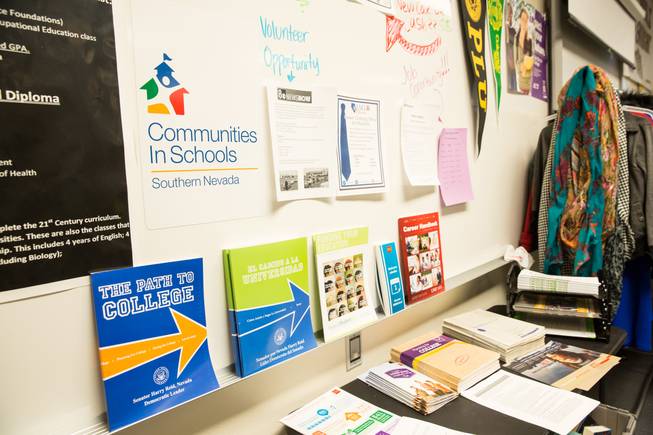
A variety of resources are avaiable for students in need at the Communities in Schools classroom at Sunrise Mountain High School, Friday Jan. 13, 2017.
Tuesday, Feb. 14, 2017 | 2 a.m.
Students with disabilities in Nevada face tough odds when it comes to advancing through grade school and college, according to a new report.
The report, put out this week by the Guinn Center for Policy Priorities, calls attention to some stark numbers for the state. In the 2014-15 school year, a quarter of students with disabilities graduated statewide, and of those who graduated, only a quarter had enrolled in college within a year.
Perhaps unsurprisingly, the Silver State stands in stark contrast to the rest of the country, where around 63 percent of special-needs students graduate each year. But that's far from success, the report notes: Students without disabilities are around 20 percent more likely to graduate than their classmates with special needs.
It raises interesting questions not only for Nevada but the country as a whole. Legislation dating back to the 1970s requires states to spend whatever is necessary to accommodate disabled students in the form of something called an IEP, or an Individualized Education Program. IEP's are drawn up by educators and parents detailing the needs of each special-needs student, and then states and school districts spend the money to carry them out with the goal of preparing the child for college and getting a job after school. However, the study notes that only 25 percent of those with intellectual disabilities are employed nationwide.
In Nevada, about one in 10 students have an IEP, with rural counties having a ratio closer to two in 10. But the gap between Nevada's disabled students and those without intellectual disabilities is the second highest in the country. Special-needs students nationwide are twice as likely to graduate than their peers in the Silver State, which ranks last in this area in the southwest. Further, data show that those with disabilities in Nevada are twice as likely to live in poverty later in life than those who aren't disabled.
What is causing this? In conversations with disabled students and their parents, researchers found a "widespread" confusion about families' rights and available services under federal law. The paralyzing effect of Nevada’s ongoing teacher shortage, precipitated by a combination of high stress and low pay in the profession nationwide, has also exacerbated the problem.
The state’s largest shortage is in special education teachers, and 83 percent of those vacancies are in low-income schools already plagued by a lack of adequate funding and shortages of other educators.
While the report paints a bleak picture of the state of things in Nevada, it does offer solutions. For families, the Guinn Center recommends contacting advocates to learn about legal rights, and for districts, administrators should expand proven programs for transitioning special-needs students to college and taking advantage of state bonuses for teachers in high-need schools.
You can read the full report here.

Join the Discussion:
Check this out for a full explanation of our conversion to the LiveFyre commenting system and instructions on how to sign up for an account.
Full comments policy